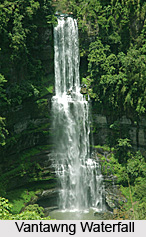 Proving true to its name as "the home of the highlanders," Aizawl, the capital of the northeastern state of Mizoram, is located at an altitude of 3500 feet above sea level. It is the seat of a rich tribal cultural extravaganza and is famous for its handicrafts. The town is blessed with exotic natural beauty. While the river Tlawng flows quietly on the east, on the north one can see the jagged hills of Durtlang.
Proving true to its name as "the home of the highlanders," Aizawl, the capital of the northeastern state of Mizoram, is located at an altitude of 3500 feet above sea level. It is the seat of a rich tribal cultural extravaganza and is famous for its handicrafts. The town is blessed with exotic natural beauty. While the river Tlawng flows quietly on the east, on the north one can see the jagged hills of Durtlang.
Location
Aizawl is situated towards the central part of the state and is flanked by rivers and rapids. It is at a distance of 466 km from Guwahati, 366 km from Shillong, and 140 km from Silchar. The Durtlang Hills constitute a natural barrier immediately south of Aizawl, their high ridges punctuated by Mizo villages and Christian missions, and provide pleasant rambling country. Aizawl perches precariously on the steep slopes of a sharp ridge, straddling the watershed between the Tlawng and the Tuirial river valleys at an altitude of 1100 m. Although it may lack a snowy Himalayan backdrop, it has something of the feel of a Himalayan hill station. It is generally cool during the summers with temperatures ranging from 20 to 30`C and heavy rains during the months of May to September. Winter temperatures range from 10 to 20`C. Fog is commonplace, and the first rays of the sun drive it away to make way for the mountain peaks-a sight that often attracts many tourists.
 Excursion
Excursion
Tamdil Lake is located at distance of 85 km from Aizawl and is a good picnic spot with boating facilities. For an admirer of natural beauty, Vantwang Falls are at a distance of about 137 km, providing a breathtaking sight of water falling amidst bamboo forests. To take a fantastic view of the Myanmar hills, one can visit Champai, about 192 km from Aizawl. Luangmual is at a distance of 7 km from Aizawl and is a small village known for its handicrafts center.
The State Museum at Babu Tlang is worth visiting and one can have a glimpse of Mizo dresses, implements, historic relics, and other traditional items. The mini zoo has some rare Asian animals in it and the most important one is the endangered sun bear. The Cultural Sub-Center is a good retreat center from the cacophony of modern life and is provided with modern amenities, while providing alluring natural sights. There are a few other attractions as well. These include the zoological garden, Bung picnic spot, MAHCO Showroom, Treasury Square, Vengthlang, and Bethlehem.
Getting There
Many in the poulation are from Myanmar.It is connected to Silchar via National Highway No. 44 and the nearest major rail junction is at Lumding, a further 180 km north of Silchar. There are regular flight of Indian airlines from Aizawl to Calcutta and the journey takes approximately two hours time



















